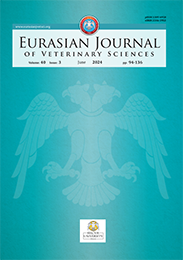| 2019, Cilt 35, Sayı 3, Sayfa(lar) 131-138 |
| [ Türkçe Özet ] [ PDF ] [ Benzer Makaleler ] |
| Molecular investigation of Feline Herpesvirus 1 (FHV-1) and Feline Calicivirus in cats with respiratory system problem |
| Seval Bilge Dağalp1, Fırat Doğan2, Touraj Aligholipour Farzani1, Ali Rıza Babaoğlu3, Gülizar Acar Kırmızı4, Mehmet Çabalar5 |
| 1Ankara Üniversitesi, Veteriner Fakültesi, Viroloji Anabilim Dalı, Ankara, Türkiye 2Hatay Mustafa Kemal Üniversitesi, Veteriner Fakültesi, Viroloji Anabilim Dalı, Hatay, Türkiye 3Van Yüzüncü Yıl Üniversitesi Veteriner Fakültesi, Viroloji Anabilim Dalı, Van, Türkiye 4Atatürk Üniversitesi, Veteriner Fakültesi, Viroloji Anabilim Dalı, Erzurum, Türkiye 5Harran Üniversitesi, Veteriner Fakültesi, Viroloji Anabilim Dalı, Şanlıurfa, Türkiye |
| Keywords: Feline Herpesvirus 1, Feline Calicivirus, PCR, Sequence analysis |
| Downloaded:1640 - Viewed: 2958 |
|
Aim: The aim of this study was to investigate the presence / prevalence of these infections
in FHV (Feline Herpesvirus) and FCV (Feline Calicivirus) suspected samples, to correlate
them with reported symptoms and molecular characterization of these viruses.
Materials and Methods: For this purpose, a total of 119 specimens were collected from 70 from cats clinically showing respiratory system problem, 31 nasal, 30 conjunctival, 8 oral, 7 orafarengeal and 11 rectal swaps and 32 EDTA blood samples. Viral nucleic acid extraction was performed from the samples and the presence of these infections was investigated by PCR. Samples with positive results were subjected to sequence analysis for molecular characterization. Results: Sampled cats were evaluated as positive for 45.71% (32/70) FHV-1 and 10% (7/70) FCV. 4,29% (3/70) of these cats were positive for both infections. FHV-1 infection was more common in cats with respiratory system findings. While age-conscious cats were observed in all age groups; especially oral and / or orafarengeal swap samples were found to be sensitive samples in the diagnosis of both infections. Conclusion: These infections, as well as being seen in infected cats, can also be detected in healthy-looking animals and it should be noted that this should not be ignored in the transmission of these infections. Therefore, in order to reduce the severity of the clinical symptoms, to minimize the scattering and persistence, it is necessary to focus on the regular vaccination of the cats that live together, especially in the community. In addition, factors other than FHV and FCV (bacteria such as M.felis, C.felis, B.bronchoseptica) can be found in cats with respiratory, eye and oral lesions and these factors should be checked in infected cats. |
| [ Türkçe Özet ] [ PDF ] [ Benzer Makaleler ] |





